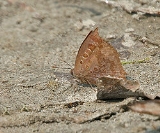
Arhopala amantes
Encyclopedia
The Large Oakblue, Arhopala amantes is a species of lycaenid
or blue butterfly
found in Asia
.
In the female, the blue scales are restricted to the center and basal part of both wings;
the outer margins are marked by a wide black band.
It is a butterfly of the canopy of small trees, occasionally coming down to settle on shrubs and low bushes.
It flies about a great deal during the day but often with long periods of resting in between flights.
To rest, it usually selects a leaf exposed to full sun at a considerable height above ground.
The eggs are laid on the leaves of Syzygium spp.The larvae and pupae are always attended by red ants.
It is not endangered.
Lycaenidae
The Lycaenidae are the second-largest family of butterflies, with about 6000 species worldwide, whose members are also called gossamer-winged butterflies...
or blue butterfly
Butterfly
A butterfly is a mainly day-flying insect of the order Lepidoptera, which includes the butterflies and moths. Like other holometabolous insects, the butterfly's life cycle consists of four parts: egg, larva, pupa and adult. Most species are diurnal. Butterflies have large, often brightly coloured...
found in Asia
Asia
Asia is the world's largest and most populous continent, located primarily in the eastern and northern hemispheres. It covers 8.7% of the Earth's total surface area and with approximately 3.879 billion people, it hosts 60% of the world's current human population...
.
Gallery
Arhopala amantes is largest lycanid in Sri Lanka.It's surprisingly inconspicuous on the wing despite the brilliant metallic blue markings on its upper side.In the female, the blue scales are restricted to the center and basal part of both wings;
the outer margins are marked by a wide black band.
It is a butterfly of the canopy of small trees, occasionally coming down to settle on shrubs and low bushes.
It flies about a great deal during the day but often with long periods of resting in between flights.
To rest, it usually selects a leaf exposed to full sun at a considerable height above ground.
The eggs are laid on the leaves of Syzygium spp.The larvae and pupae are always attended by red ants.
It is not endangered.

